psycho 70
__
2002
Installation
Govett-Brewster Art Gallery,
New Plymouth, Neuseeland
Film
DV auf DVD-PAL/4:3 und 16:9
115 min Doppelprojektion
(der 16:9- und 4:3-Aufnahmen)
Projektionsgröße: 1:1 zur Wohnung Regie und Kamera: Maix Mayer
Darstellerin: Liane Mayer
2002
Installation
Govett-Brewster Art Gallery,
New Plymouth, New Zealand
Film
DV on DVD-PAL, 4:3 and 16:9
115 min double projection
(of the 16:9 and 4:3 recordings)
Projection size: 1 to 1 to the
apartment
Directed by, camera: Maix Mayer
Actress: Liane Mayer
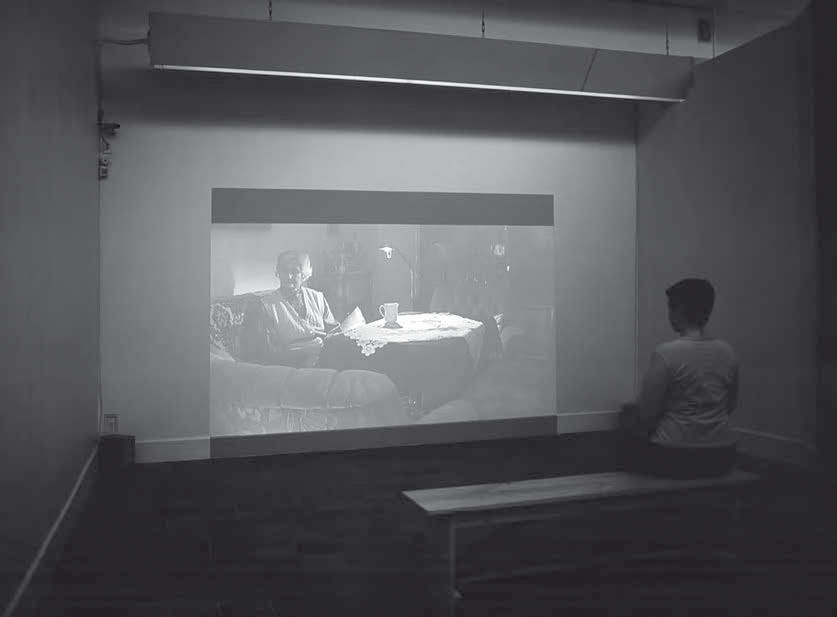
Installationsansicht
Installation view
Im Film ist die Mutter des Künstlers zu sehen, wie sie sich zum ersten Mal den von Alfred Hitchcock inszenierten Thriller Psycho (1960) anschaut. Sie betritt ihr Wohnzimmer, sitzt auf dem Sofa, schaut sich den Film an und verlässt nach dessen Ende wieder den Raum.
Zwei Kameras verfolgen aus einer Zuschauerposition die sitzende Frau, während sich das Fernsehbild in der Schrankwand spiegelt und der Originalton sowie die Geräusche des Raumes sich mischen. Die erste Kamera zeichnete die Szene statisch in der Totalen im 16:9-Kinoformat auf, während man bei der zweiten für die gleiche Aufzeichnung mit einem Zoom auf Halbnah im 4:3-Fernsehformat arbeitete.
Der Filmtitel psycho70 spielt auf den Plattenbautyp „WohnBauSystem 70“ an. Über 40 Prozent der bis 1990 in der DDR errichteten Wohneinheiten befanden sich, wie die Wohnung der Mutter, in solchen Hochhäusern. Der Film wurde erstmals in einem Kunstmuseum gezeigt, das vor dem Umbau selbst ein Kino gewesen war. Die Filmprojektion erfolgte an der Stelle, wo sich damals die Kinoleinwand befand.
In this film we see the artist’s mother as she watches Alfred Hitchcock’s thriller Psycho (1960) for the first time. She enters her living room, sits down on the sofa, watches the movie, and leaves the room again when it is finished.
Two cameras are trained on the seated woman, while the television picture is reflected in the glass cabinet and the sound of the movie is mixed with the sounds of the room. The first camera records the scene statically in wide 16:9 cinema format, while the same scene is recorded in a 4:3 television format mid-shot using a zoom.
The film title psycho70 is a play on the name of the apartment block, “WohnBauSystem 70”. More than 40 percent of the apartments built in East Germany to 1990 were – like the mother’s apartment – in this kind of block. The film was first shown at an art gallery that, before its renovation, had been a cinema. The projection was made on the surface where the movie screen had been.

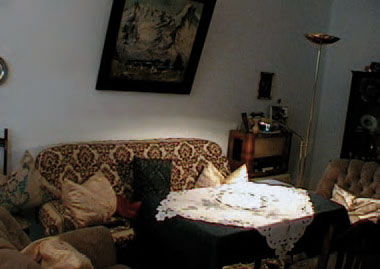
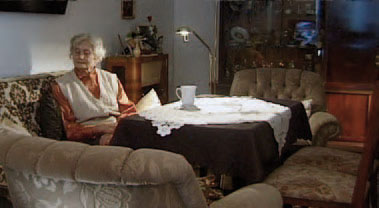
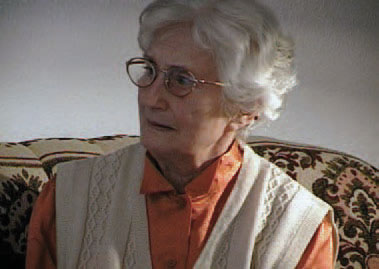
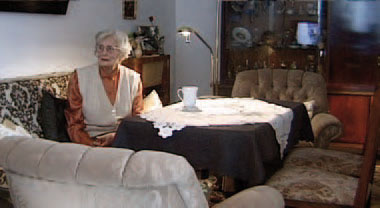
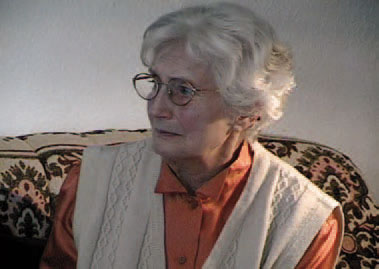
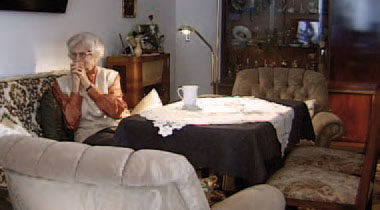
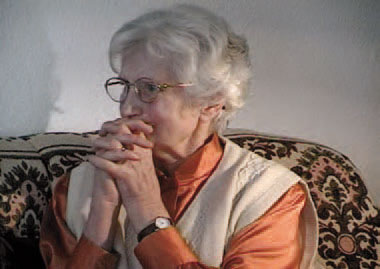
Filmstills
Movie stills
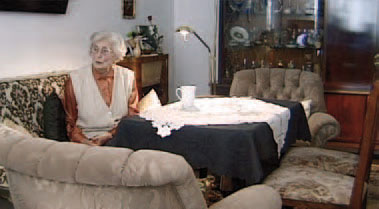
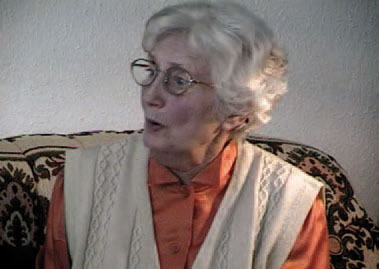
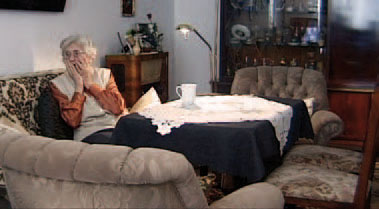
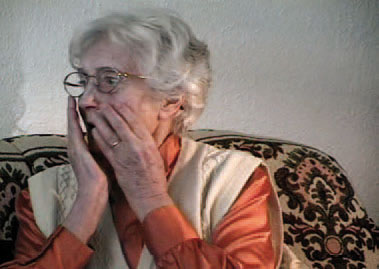
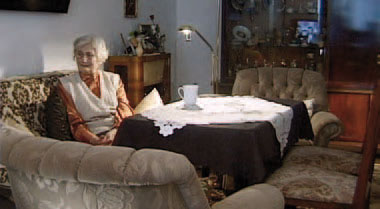
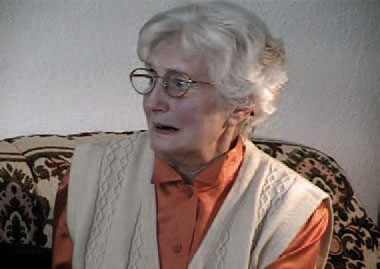
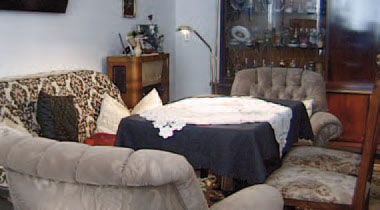
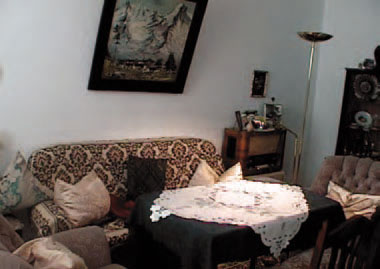
Filmstills
Movie stills
______________
Mutter. Hier und Dort.
Marc Ries, Winfried Pauleit
A
Wir verfügen über zwei Ansichten. Die eine im 16:9-Format zeigt ein Kinobild. Es ist ein Bild als Totale, d. h. als Fülle, die totale, allumfassende Aufnahme der Ecke eines Wohnzimmers. Das Bild ist also „groß “, es eröffnet einen Blickraum, in welchem sich das Zimmer entfalten kann, alle Dinge sind, wenngleich „klein“, da in exakten Proportionen zueinander abgebildet, sichtbar, sie vermögen Auskunft zu geben über die Ordnungen dieses Ortes, über das konzentrische Leben in Wohnzimmern. Wenn die alte Frau Platz nimmt, wird auch sie ein Element der Konstellation der Dinge sein.
Eigentlich lässt in diesem Gefüge nichts den Schluss zu, dass ihre Position herausgehoben ist, sie wirkt äquivalent, gleich wichtig, eingebettet in das Universum der wohnenden Dinge. Wenn man den Ort aristotelisch als ein Umfassendes denkt, das eine unmittelbare, unbewegliche Grenze zum umfassten Körper bildet, dann hat dieses Bild Definitionsmacht: Alle Körper bilden einen Ort als ein Umfassendes aus, das von diesen Körpern nicht zu trennen ist. Also sagen alle und alles stets: Dies ist mein Zuhause! Und auch wir als Zuschauer sind eingeladen, dieses Wohnen zu teilen, uns einzusehen, mitzuwohnen. In einer 1:1-Projektion wird der filmische mit dem realen Ort zusammenfallen, Bild und Sein eins werden.
Dennoch ist im Bild, besser im Off des Bildes, eine St rung angelegt. Denn die Frau nimmt nur Platz, um aus dem Bild, aus dem Wohnraum hinauszuschauen. Man sieht diesen anderen Ort ihres Blicks als Spiegelung im Glas einer Vitrine, und man hört diesen Ort: Es ist ein Fernseher. Also eine Apparatur, die selbst Bilder hervorruft, Bilder nicht von diesem Empfangsort, sondern von einem Außerhalb – hier einem bekannten narrativen Raum der Kinogeschichte. Der Fernseher bricht die geschlossene Zelle des bürgerlichen Interieurs auf und evoziert eine empfangsbereite Außenwendung, schreibt Martin Warnke. Eine Wendung ganz woanders hin, die die Binnenwelt des Wohnzimmers aufzehrt, sie zumindest entkräftet.
Wozu nun also all die stillen, friedlichen, ruhenden, schützenden Dinge, wozu der Schmuck und das Bild einer Bergnatur an der Wand, wenn diese andere Technik die Bewohnerin in die harsche K lte einer unbegreiflichen Außenwelt entlässt? Wir sehen also ein Kinobild, das ein mit ihm konkurrierendes Bildregime vorführt, wenngleich dieses andere Regime selbst wiederum Kino als Video zeigt. Die alte Frau sieht Alfred Hitchcocks Thriller Psycho von 1960 im Fernseher in ihrem Wohnzimmer. Lässt sich damit sagen, dass die eine Mutter der anderen in ihrer eigenen Privatheit beiwohnt? Immerhin ist der Fernseher (im Gegensatz zum Kinoraum) ja auch Teil des Mobiliars.
Die zweite Ansicht ist die des Fernsehens selber, es ist die halb nahe 4:3-Einstellung der Frau, die uns im „kleinen“ Bild sehr „groß“ begegnet. Nun sind wir aufgefordert, den Blick zu disziplinieren, die vielen Dinge um die Frau zu vergessen, die drei verbleibenden Objekte – Frau, Sofa, Wand – zu beobachten, sie zu analysieren, eine Mikrostudie ihrer Eigenheiten anzufertigen. Weniger stellt uns das Bild eine Geschichte vor, in die wir uns „einwohnen“, das schematische Bildfeld konfrontiert uns vielmehr mit einer intensiven Faktizität. Auffällig sind zunächst die vielen Muster: zunächst das ornamentale des Sofas, das auf der Strickweste und das der Bluse, aber auch das Muster der Raufasertape. Zugleich werden wir gedrängt, die physiognomischen Muster der Frau zu studieren: Alsbald registrieren wir die affektiven Veränderungen, die Vibrationen und Spannungen in ihrem Gesicht.
Während das eine Fernsehbild, das Ursache der Erregung ist, Kino simuliert, ist das andere ein tatsächliches, es bildet eine Kommunikationsstruktur aus – die der Mutter mit ihrem Anderen – und generiert zugleich eine solche: Die halb nahe Einstellung determiniert unsere Lektüre des Bildes als eine beobachtende, analysierende, kontrollierende. Nun wohnen wir nicht mehr im Bild, sondern kommunizieren mit dessen Daten. Wir verfolgen, ja vermessen rigoros, wie die psycho-dramatische Zirkulation einer Mutter-Sohn Beziehung das Verhalten einer anderen Mutter affiziert.
B
Wir sehen eine ältere Frau in ihrem Wohnzimmer. Die Kamera ist starr und wird starr eingerichtet bleiben. Sie wird – und wir mit ihr – die Frau beobachten in den nächsten 107 Minuten. Das ist genau jene Zeit, die die Frau mit dem Anschauen eines Films auf ihrem Fernseher verbringt: Hitchcocks Thriller Psycho. Wir werden also beim Zuschauen zuschauen. Unsere Perspektive ist jedoch weniger spannungsgeladen, vom „suspense“ strukturiert, als die unserer Protagonistin. Uns wird keine schnell geschnittene Mordszene in der Dusche erwarten noch irgendein spezifischer Dialog. Der Film, den die Protagonistin sieht, bleibt uns weitgehend verborgen. Unsere Position ist die eines unmöglichen Gegenschusses, der die Zuschauerseite sichtbar macht. Was wir vom Film erfahren, zeigt sich in den Spiegelungen einer Glasvitrine, die uns den matten Abglanz eines schwarz-weißen Fernsehbildes reflektiert und die Schemata eines Fernsehschirms und den Wechsel von Hell-Dunkel anzeigt, so wie man es nächtens von der Straße in den von Fernsehern beleuchteten Fenstern sehen kann.
Auch ein Ton ist hörbar: die deutsche Synchronisation des Filmtons, ganz leise und kaum vernehmlich, und bereits während des Vorspanns der bekannte einpeitschende Beat der Filmmusik, der schon jetzt auf den Mord zusteuert. Und dann sehen wir noch die minimalen Reaktionen unserer Zuschauerin. Zu Anfang ist sie am Filmgeschehen
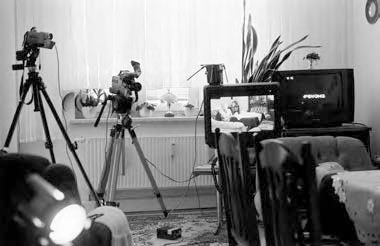
Mother. Here and There.
Marc Ries, Winfried Pauleit
A
There are two views available to us. The 16:9 format shows a cinema image. It is a wide shot, going to the full extent, the total, all-encompassing picture of a corner of a living room. Thus, the image is “large,” it opens up a field of view in which the room can unfold; everything is portrayed there in exact proportion to everything else, even though “small.” The objects are visible; they can provide information on the layers of order in this place, on the concentric nature of life in living rooms. When the old woman takes her seat, she too becomes an element in the arrangement of things. Nothing in this constellation really suggests that her position is a special one; it is equivalent, equally important, set into the universe of living room things. If you consider the place in an Aristotelian fashion as a contained one that forms an immediate, immobile border to the contained body, then this image has the power of definition: all bodies develop a contained place from which they cannot be separated. Thus, everyone and everything constantly proclaims: This is my home! And we as observers are invited to share in this existence, to take a look inside, to join in this life. In a one-to-one projection, the film location will coincide with the real location, image and being become one. Nevertheless, there is a disturbance in the image, or rather off camera. For the woman only sits where she sits so as to look out of the picture, out of the living space. We see this other place – the one she is looking at – as a reflection in a glass cabinet, and we hear it as well – it is a television set. It is an apparatus that itself produces images, images that are not of this place where they are being received, images from an outside world. This is a familiar narrative space from the history of cinema. The television breaks open the closed cell of the bourgeois interior, evoking a receptive exterior turn, writes Martin Warnke. A turn to a completely different place, which exhausts the interior world of the living room, or at least robs it of strength. Why have all these quiet, peaceful, restful, protective things? Why the decoration and the picture of a mountain landscape on the wall – when this other technology releases the occupant into the hard, cold existence of an incomprehensible outside world? It appears we are looking at a cinema image that presents a regime of images competing with itself, even though this other regime, in turn, reveals itself to be cinema on video. The old woman is watching Alfred Hitchcock’s Psycho on her television in her living room. Can we now say that the one mother is present with the other mother in her own private sphere? After all, the television set (unlike a cinema) is part of the furniture.
The second view we could take is that of the television itself – it is the 4:3 mid-shot of the woman, who, in this “small” picture appears very “big” to us. Now we face the challenge of disciplining our view, forgetting all the things around the woman, and observing the three remaining objects – woman, sofa, wall – analyzing them, carrying out a micro-study of their peculiarities. The picture before us does not really present us with a story that we can become comfortable with, rather, the schematic nature of what we see presents us with an intense factuality. The first thing that is noticeable is the many patterns – the ornamental pattern on the sofa, that on the knitted waistcoat and on the blouse – but there is also the pattern of the wallpaper. At the same time, we are forced to study the physiognomic pattern of the woman herself. And quickly we register the affective changes, the vibrations and tensions in her face. While the television images that cause this arousal simulate cinema, the other television image is an actual one, it forms a communication structure – that of the mother with her Other – and at the same time generates an image such as this: the mid-shot determines our reading of the picture as an observing, analyzing, controlling one. Now we no longer live in this picture; rather, we are communicating with the data in the picture. We are following, indeed, we are rigorously measuring, how the psycho-dramatic circulation of a mother-son relationship affects the behavior of another mother.
B
We see an elderly woman in her living room. The camera is fixed and will remain in its fixed position. It will observe the woman for the next 107 minutes – and we will do so with it. The period of 107 minutes is the exact time the woman spends watching a movie on television: Hitchcock’s Psycho. Thus, we will watch the watching. But our perspective is not charged with and structured by suspense as that of our protagonist is. We cannot expect any little fast-cut murder scene in the shower, nor any specific dialogue. The movie the protagonist is watching remains largely hidden to us. Our position is one of an impossible back shot that makes the audience visible. All that we experience of the movie is revealed in the reflection in a glass cabinet – this shows us the faint mirror image of a black-and-white television picture and the outline of a television screen and the flickering of light and dark, just as one sees in the windows of rooms lit only by a television when one is on the street at night. The sound is also there, very low and barely audible – you can hear the German synchronization of the original sound and even the familiar lashing beat of the music – which even now takes us toward murder – during the opening credits. And then we see the still minimal reactions of our watcher. At first, she is not particularly interested in what is happening in the film. She looks time and time again, somewhat furtively, at the camera, to a person who may be behind it. Later, at the most tense moments of the movie, we will be able to clearly see intense reactions in her body and perhaps to discern the tiny movements in her face which most clearly reveal identification and compassion with the events taking place in the movie. But beyond this affecting time track of the film – which we know from other films and which we can now observe from the detached position of the sociologist or psychologist – we can also see the everyday world of the living room, as a second time track which goes on forever – armchair, sofa, dining chairs, a table with a tablecloth, the focal point of the bourgeois living room. In the background there is another piece of equipment, a radio, on which a vase, a picture in a frame – possibly a photograph – and other things are presented as if on a little altar. Thus, between the radio and the television there is an old, non-technical communication space which invites one into this home, while at the same time expressing its desolation – a parallel with the Hitchcock movie, in which a deserted hotel with no more guests becomes the focus of the film. However, in the Hitchcock it is a surviving son who preserves his mother’s memory in his eccentric fashion; while in the living room shown to us, the mother is the living protagonist, while the son – if he exists – seems to have disappeared. One could imagine him behind the camera, or in the figure on all fours that sometimes – rather eerily – becomes visible on the right-hand edge of the picture. This communication space is set into the scene. It is the true object of this video work. Hitchcock’s Psycho provides the foil for it. And against this background, a specific space becomes tangible. The patterns on the armchairs and dining chairs attain their own characteristic presence; the woman’s single coffee cup on the table becomes the stigma of a desolation, expression of a non-communication papered over with technological media. In contrast to the movie, this time track does not lead to a murder; it leads to nothing at all. She wants to last, to be ready for a return of possible guests who cannot be found. And then, the telephone really does ring …